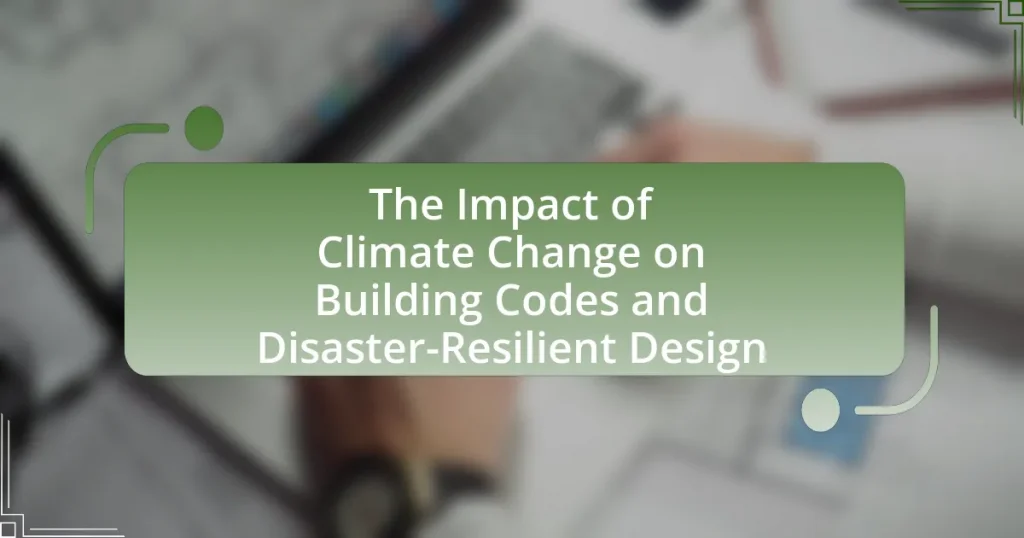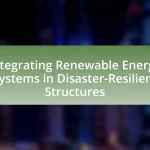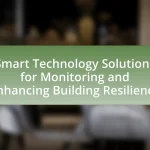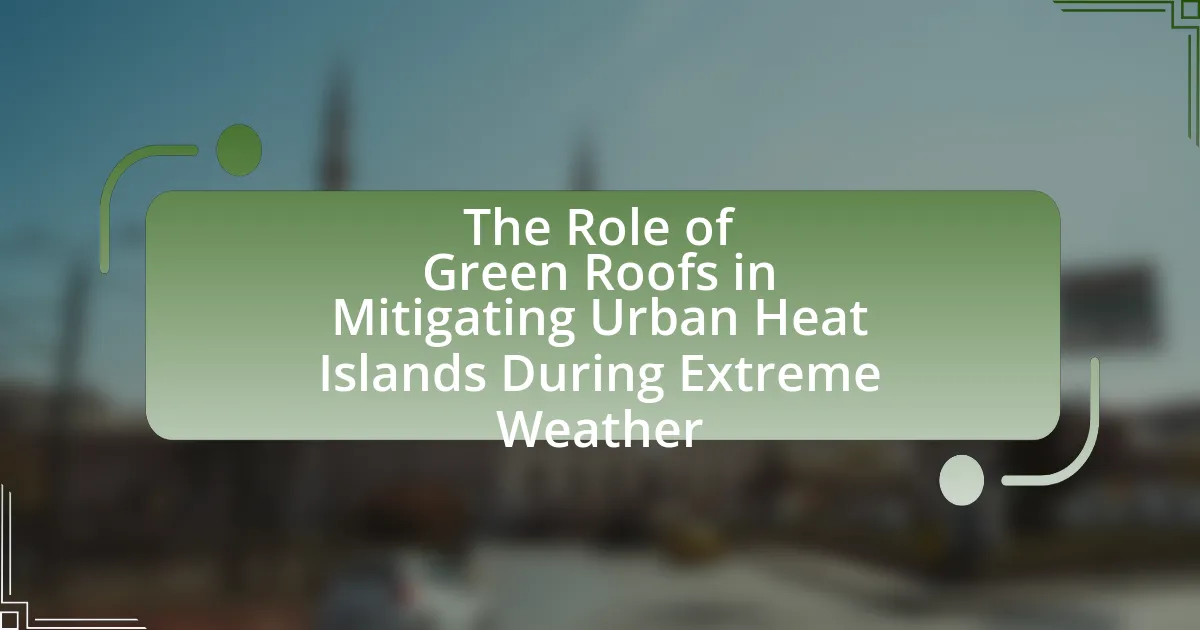The article examines the impact of climate change on building codes and disaster-resilient design, highlighting the necessity for stricter regulations and innovative construction practices to address increasing climate-related risks. It discusses how building codes are evolving to incorporate resilience measures against extreme weather events, such as floods and hurricanes, and emphasizes the importance of sustainable materials and energy-efficient systems. Key principles of disaster-resilient design, stakeholder involvement in code adaptation, and the economic implications of these changes are also explored, underscoring the critical role of updated building codes in safeguarding communities and infrastructure against climate change.
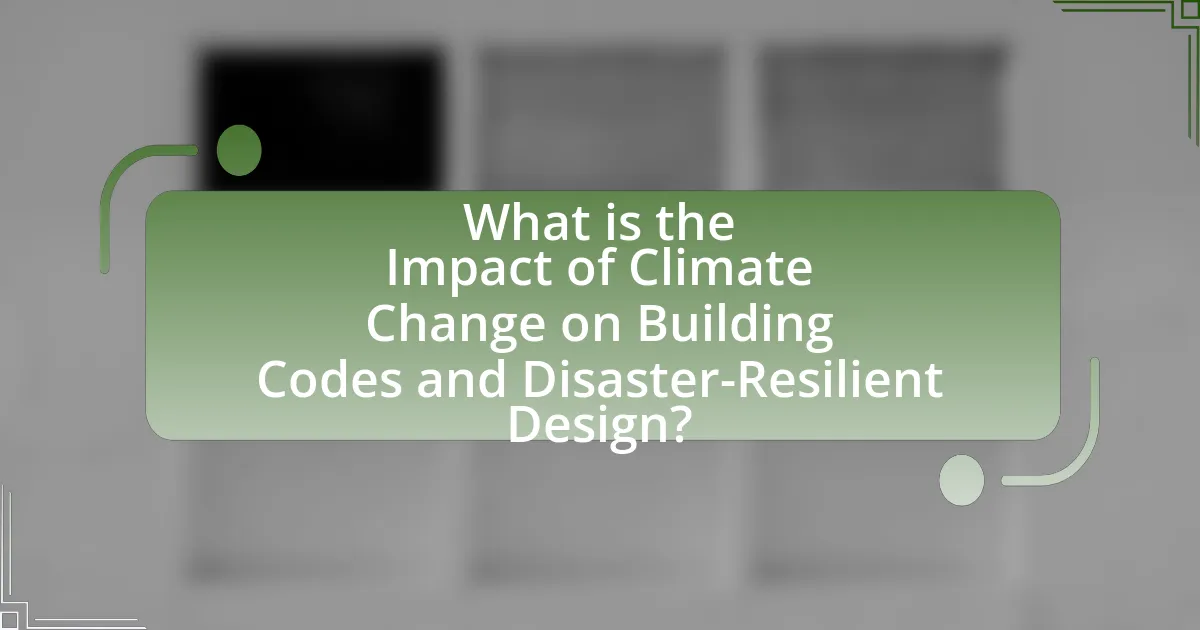
What is the Impact of Climate Change on Building Codes and Disaster-Resilient Design?
Climate change significantly impacts building codes and disaster-resilient design by necessitating stricter regulations and innovative construction practices. As extreme weather events become more frequent and severe, building codes are evolving to incorporate resilience measures that address flooding, hurricanes, wildfires, and other climate-related risks. For instance, the International Code Council has updated its codes to include provisions for elevated structures in flood-prone areas, reflecting the need for adaptation to rising sea levels. Additionally, disaster-resilient design emphasizes the use of sustainable materials and energy-efficient systems, which not only mitigate environmental impact but also enhance the durability of buildings against climate-induced stresses. This shift in building codes and design practices is crucial for safeguarding communities and infrastructure in the face of ongoing climate change.
How does climate change influence building codes?
Climate change influences building codes by necessitating stricter regulations to enhance resilience against extreme weather events and rising sea levels. As climate-related risks increase, building codes are updated to incorporate requirements for energy efficiency, flood resistance, and sustainable materials. For instance, the International Code Council has revised codes to include provisions for wind resistance in hurricane-prone areas and floodplain management standards in regions susceptible to flooding. These adaptations aim to reduce vulnerability and ensure that structures can withstand the impacts of climate change, thereby protecting public safety and property.
What specific changes are being made to building codes in response to climate change?
Building codes are being updated to enhance resilience against climate change by incorporating stricter standards for energy efficiency, flood resistance, and sustainable materials. For instance, many jurisdictions are now mandating the use of reflective roofing materials to reduce heat absorption and improve energy efficiency, as outlined in the International Energy Conservation Code. Additionally, codes are increasingly requiring elevated construction in flood-prone areas to mitigate flood damage, reflecting guidelines from the Federal Emergency Management Agency. These changes aim to reduce the environmental impact of buildings while ensuring safety and sustainability in the face of climate-related challenges.
How do these changes aim to improve resilience against climate-related disasters?
Changes in building codes and disaster-resilient design aim to improve resilience against climate-related disasters by incorporating stricter standards for materials, structural integrity, and environmental considerations. These updated codes require buildings to withstand extreme weather events, such as hurricanes and floods, by mandating features like elevated foundations, reinforced structures, and energy-efficient designs. For instance, the Federal Emergency Management Agency (FEMA) recommends elevating buildings in flood-prone areas to reduce damage risk, which has been shown to significantly lower repair costs and enhance safety during disasters.
Why is disaster-resilient design important in the context of climate change?
Disaster-resilient design is crucial in the context of climate change because it enhances the ability of structures to withstand extreme weather events and natural disasters, which are becoming more frequent and severe due to climate change. As global temperatures rise, the frequency of hurricanes, floods, and wildfires increases, necessitating building practices that prioritize safety and sustainability. For instance, the National Oceanic and Atmospheric Administration (NOAA) reported that the number of billion-dollar weather and climate disasters in the U.S. has significantly increased, highlighting the urgent need for resilient infrastructure. Implementing disaster-resilient design not only protects lives and property but also reduces economic losses and recovery costs associated with climate-related disasters.
What are the key principles of disaster-resilient design?
The key principles of disaster-resilient design include risk assessment, sustainable materials, flexible design, redundancy, and community involvement. Risk assessment involves identifying potential hazards and vulnerabilities to inform design decisions. Sustainable materials enhance durability and reduce environmental impact, while flexible design allows structures to adapt to changing conditions. Redundancy ensures that critical systems remain functional during disasters, and community involvement fosters local knowledge and support for resilience strategies. These principles are supported by studies indicating that buildings designed with these factors in mind can significantly reduce damage and enhance recovery after disasters.
How does disaster-resilient design mitigate risks associated with climate change?
Disaster-resilient design mitigates risks associated with climate change by incorporating features that enhance structural integrity and adaptability to extreme weather events. This design approach includes the use of materials and construction techniques that withstand flooding, high winds, and seismic activity, thereby reducing damage during climate-related disasters. For instance, buildings designed to be elevated above flood levels can prevent water damage, while reinforced structures can endure stronger storms. Research indicates that implementing disaster-resilient design can reduce economic losses by up to 50% during extreme weather events, demonstrating its effectiveness in safeguarding communities against the impacts of climate change.
What role do stakeholders play in adapting building codes for climate resilience?
Stakeholders play a crucial role in adapting building codes for climate resilience by providing essential input, expertise, and resources necessary for effective code development. These stakeholders include government agencies, architects, engineers, builders, community organizations, and the public, all of whom contribute to identifying vulnerabilities and proposing solutions that enhance resilience against climate-related risks. For instance, the Federal Emergency Management Agency (FEMA) emphasizes the importance of stakeholder engagement in the National Flood Insurance Program, which encourages local governments to adopt updated building codes that reflect current climate data and risk assessments. This collaborative approach ensures that building codes are not only scientifically informed but also reflect the needs and priorities of the communities they serve, ultimately leading to more sustainable and resilient infrastructure.
Who are the key stakeholders involved in the process of updating building codes?
The key stakeholders involved in the process of updating building codes include government agencies, building professionals, industry associations, and community organizations. Government agencies, such as local and state building departments, are responsible for enforcing codes and ensuring compliance with safety standards. Building professionals, including architects, engineers, and contractors, contribute technical expertise and practical insights into the feasibility of code changes. Industry associations, like the International Code Council, advocate for best practices and provide resources for code development. Community organizations represent the interests of residents and advocate for safety and sustainability in building practices. These stakeholders collaborate to ensure that building codes reflect current knowledge, including considerations related to climate change and disaster resilience.
How do stakeholder interests influence the development of disaster-resilient design standards?
Stakeholder interests significantly influence the development of disaster-resilient design standards by shaping the priorities and requirements that guide these standards. Various stakeholders, including government agencies, architects, engineers, community organizations, and the public, contribute diverse perspectives and needs that must be addressed in the design process. For instance, government agencies often prioritize public safety and regulatory compliance, while community organizations may emphasize social equity and accessibility in disaster response. Research indicates that incorporating stakeholder feedback leads to more effective and widely accepted design standards, as seen in the Federal Emergency Management Agency’s (FEMA) guidelines, which integrate input from local communities to enhance resilience. This collaborative approach ensures that the standards are not only technically sound but also socially relevant, ultimately leading to more robust disaster preparedness and response strategies.
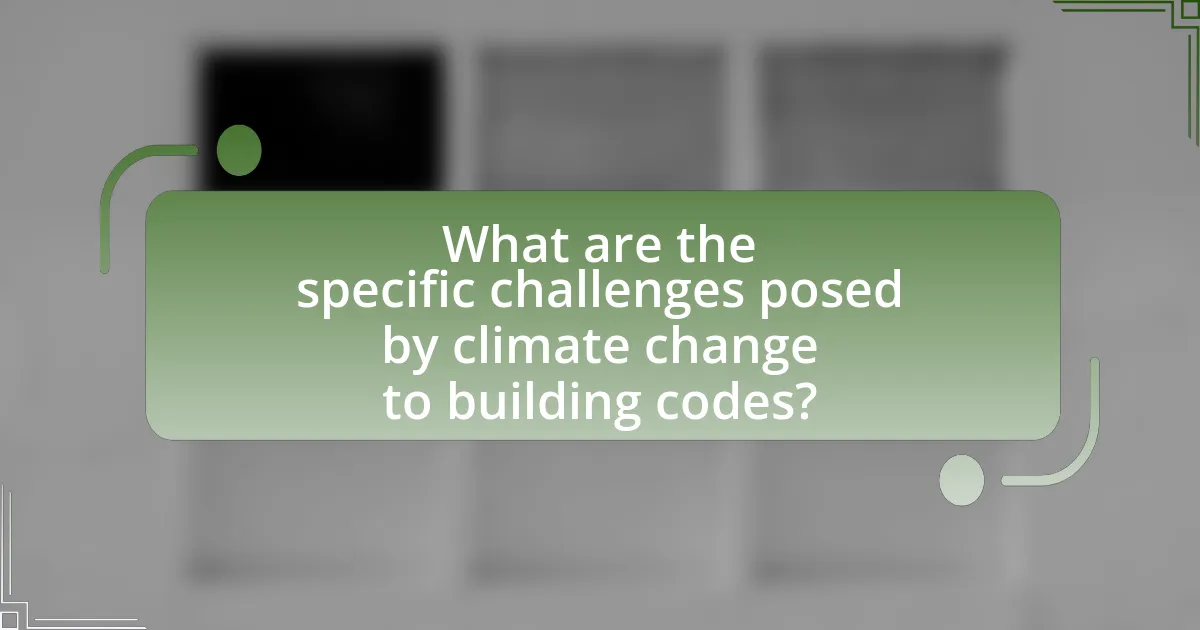
What are the specific challenges posed by climate change to building codes?
Climate change poses specific challenges to building codes by necessitating updates to address increased risks from extreme weather events, rising sea levels, and temperature fluctuations. These challenges include the need for enhanced structural integrity to withstand more severe storms, the incorporation of flood-resistant designs in coastal areas, and the adaptation of materials and construction practices to cope with higher temperatures and humidity levels. For instance, the National Oceanic and Atmospheric Administration (NOAA) reports that the frequency and intensity of hurricanes have increased, prompting the need for stricter wind load requirements in building codes. Additionally, the Intergovernmental Panel on Climate Change (IPCC) highlights that rising sea levels threaten coastal infrastructure, requiring codes to integrate floodplain management and resilient design principles.
How do extreme weather events affect building regulations?
Extreme weather events significantly influence building regulations by prompting updates to codes that enhance structural resilience. For instance, following Hurricane Katrina in 2005, many states revised their building codes to require stronger wind resistance and flood-proofing measures. Similarly, the increasing frequency of wildfires has led to stricter regulations on fire-resistant materials and defensible space requirements in vulnerable areas. These adaptations aim to mitigate damage and protect public safety, reflecting a growing recognition of the need for disaster-resilient design in response to climate change.
What types of extreme weather events are most impactful on building codes?
Extreme weather events that are most impactful on building codes include hurricanes, floods, wildfires, and extreme temperatures. Hurricanes necessitate stricter wind resistance standards, as evidenced by the increased building code requirements in coastal areas following Hurricane Andrew in 1992. Floods lead to regulations regarding elevation and flood-resistant materials, highlighted by the National Flood Insurance Program’s guidelines. Wildfires prompt codes that focus on fire-resistant materials and defensible space, particularly in regions like California, which has seen devastating fires. Extreme temperatures influence insulation and energy efficiency standards, as seen in the adoption of the International Energy Conservation Code. These events drive the evolution of building codes to enhance safety and resilience against climate-related risks.
How can building codes be adapted to address these extreme weather events?
Building codes can be adapted to address extreme weather events by incorporating stricter design standards that enhance structural resilience. These adaptations include specifying materials that withstand high winds, flooding, and temperature fluctuations, as evidenced by the International Building Code’s updates post-Hurricane Katrina, which mandated elevated structures in flood-prone areas. Additionally, codes can require the integration of green infrastructure, such as permeable pavements and rain gardens, to manage stormwater effectively, as demonstrated in cities like New Orleans, where such measures have reduced flooding risks. Implementing these changes ensures that buildings are better equipped to withstand the increasing frequency and severity of extreme weather events driven by climate change.
What are the economic implications of updating building codes for climate resilience?
Updating building codes for climate resilience has significant economic implications, primarily by reducing long-term costs associated with disaster recovery and infrastructure damage. Enhanced building codes lead to structures that can withstand extreme weather events, thereby minimizing repair expenses and insurance claims. For instance, a study by the National Institute of Building Sciences found that every dollar invested in disaster mitigation through updated codes can save society an average of $6 in future disaster costs. Additionally, improved resilience can enhance property values and attract investment, as safer buildings are more appealing to buyers and businesses. Overall, the economic benefits of updating building codes manifest through reduced losses, increased property values, and enhanced community resilience.
How do updated building codes affect construction costs?
Updated building codes generally increase construction costs due to the incorporation of more stringent safety, energy efficiency, and environmental standards. These codes often require advanced materials and technologies, which can raise initial expenses. For instance, the International Code Council’s 2021 codes emphasize resilience against climate change, leading to higher upfront costs for features like enhanced insulation and flood-resistant designs. A study by the National Institute of Building Sciences found that while initial costs may rise, long-term savings from energy efficiency and reduced disaster recovery expenses can offset these increases, demonstrating a complex relationship between updated codes and overall financial impact.
What long-term savings can be achieved through disaster-resilient design?
Disaster-resilient design can achieve long-term savings by significantly reducing repair and reconstruction costs after disasters. For instance, buildings designed to withstand extreme weather events can lower insurance premiums by up to 30%, as evidenced by a study from the National Institute of Building Sciences, which found that every dollar invested in disaster mitigation can save society an average of six dollars in future disaster costs. Additionally, these designs often lead to lower maintenance costs and increased property values, further contributing to financial savings over time.
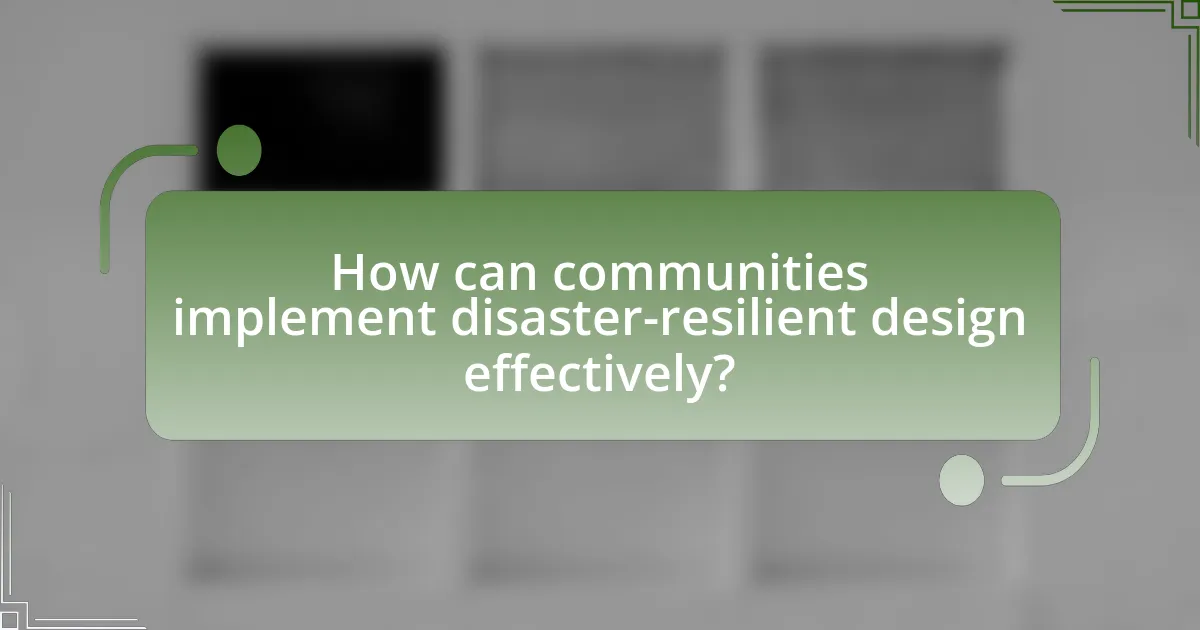
How can communities implement disaster-resilient design effectively?
Communities can implement disaster-resilient design effectively by integrating risk assessments into urban planning and building codes. This approach ensures that structures are designed to withstand specific hazards, such as floods, earthquakes, and hurricanes. For instance, the Federal Emergency Management Agency (FEMA) emphasizes the importance of using updated hazard maps and incorporating climate projections into planning processes. Additionally, communities can adopt building materials and techniques that enhance resilience, such as elevated foundations in flood-prone areas or flexible materials that can absorb seismic shocks. Evidence from the National Institute of Building Sciences indicates that resilient design can reduce disaster recovery costs by up to 50%. By prioritizing these strategies, communities can significantly enhance their preparedness and response to climate-related disasters.
What best practices should communities follow for disaster-resilient design?
Communities should implement best practices such as adopting updated building codes, utilizing sustainable materials, and incorporating green infrastructure to enhance disaster resilience. Updated building codes, informed by climate change projections, ensure structures can withstand extreme weather events, as evidenced by the International Code Council’s recommendations for wind and flood resistance. Utilizing sustainable materials reduces environmental impact and promotes longevity, while green infrastructure, such as permeable pavements and rain gardens, mitigates flooding and improves water management. These practices collectively contribute to a community’s ability to adapt to and recover from disasters effectively.
How can local governments support the implementation of these best practices?
Local governments can support the implementation of best practices in disaster-resilient design by establishing and enforcing updated building codes that reflect current climate risks. By integrating climate data and projections into these codes, local governments ensure that new constructions are designed to withstand extreme weather events, thereby reducing vulnerability. For instance, the International Code Council has developed the International Building Code, which incorporates resilience measures that local governments can adopt to enhance community safety. Additionally, local governments can provide financial incentives, such as grants or tax breaks, to encourage property owners to invest in resilient building practices. This approach not only promotes compliance with updated codes but also fosters community engagement in climate adaptation efforts.
What role does community engagement play in successful disaster-resilient design?
Community engagement is crucial for successful disaster-resilient design as it ensures that the needs, knowledge, and experiences of local populations are integrated into planning and implementation processes. Engaging communities fosters collaboration, leading to designs that are culturally relevant and more likely to be accepted and maintained by residents. Research indicates that projects with strong community involvement are 30% more effective in achieving resilience goals, as they leverage local insights to identify vulnerabilities and prioritize resources effectively. This participatory approach not only enhances the functionality of disaster-resilient structures but also builds social cohesion, which is vital during recovery efforts.
What resources are available for professionals in building design and construction?
Professionals in building design and construction can access a variety of resources, including industry standards, guidelines, and educational materials. Key resources include the International Code Council (ICC) which provides building codes and standards, the American Institute of Architects (AIA) offering design guidelines and continuing education, and the National Institute of Building Sciences (NIBS) that focuses on disaster resilience and sustainability. Additionally, online platforms such as the U.S. Green Building Council (USGBC) provide resources on sustainable building practices, while academic journals and conferences offer the latest research on climate change impacts on building codes. These resources collectively support professionals in adapting to evolving standards and enhancing disaster resilience in their designs.
Where can professionals find guidelines and standards for disaster-resilient design?
Professionals can find guidelines and standards for disaster-resilient design through organizations such as the International Code Council (ICC), the Federal Emergency Management Agency (FEMA), and the National Institute of Standards and Technology (NIST). These organizations provide comprehensive resources, including building codes, design standards, and best practices specifically aimed at enhancing resilience against disasters. For instance, FEMA’s “Building Codes Save: A Nationwide Study of the Costs and Benefits of Building Codes” outlines the effectiveness of codes in mitigating disaster impacts, reinforcing the importance of adhering to these guidelines.
What training opportunities exist for understanding climate-responsive building codes?
Training opportunities for understanding climate-responsive building codes include workshops, online courses, and certification programs offered by various organizations. For instance, the International Code Council provides training sessions focused on the latest building codes that incorporate climate resilience. Additionally, universities and professional associations often offer continuing education courses that cover the integration of climate considerations into building design and construction practices. These programs are designed to equip professionals with the knowledge needed to adapt to changing climate conditions and comply with updated regulations.
What are the future trends in building codes and disaster-resilient design?
Future trends in building codes and disaster-resilient design include increased integration of climate adaptation measures, stricter regulations for energy efficiency, and the adoption of advanced materials and technologies. Building codes are evolving to address the growing risks associated with climate change, such as flooding, wildfires, and extreme weather events. For instance, the International Code Council has been updating codes to incorporate resilience strategies, emphasizing the need for structures to withstand natural disasters. Additionally, the use of sustainable materials and smart technologies is becoming more prevalent, as evidenced by the rise in green building certifications like LEED, which promote energy-efficient and environmentally friendly construction practices.
How might emerging technologies influence building codes in the context of climate change?
Emerging technologies will significantly influence building codes in the context of climate change by enabling the integration of advanced materials, smart systems, and data analytics into construction practices. For instance, the use of sustainable materials such as carbon-negative concrete and energy-efficient insulation can lead to stricter regulations that promote lower carbon footprints in new buildings. Additionally, smart building technologies, including IoT sensors and automated energy management systems, can provide real-time data on energy consumption and environmental conditions, prompting updates to codes that require adaptive responses to climate-related risks. Research from the National Institute of Standards and Technology indicates that incorporating these technologies can enhance resilience against extreme weather events, thereby necessitating revisions in building codes to ensure safety and sustainability in the face of climate change.
What predictions can be made about the evolution of disaster-resilient design practices?
Predictions about the evolution of disaster-resilient design practices indicate a significant shift towards integrating advanced technologies and sustainable materials. As climate change intensifies the frequency and severity of natural disasters, building codes are expected to evolve, incorporating stricter regulations that mandate resilience features. For instance, the International Code Council has been updating codes to include provisions for flood-resistant construction and wind-resistant designs, reflecting a proactive approach to disaster preparedness. Furthermore, the adoption of smart technologies, such as real-time monitoring systems and adaptive building designs, will likely become standard, enhancing the ability to respond to environmental changes. These trends are supported by research from the National Institute of Building Sciences, which emphasizes the economic benefits of investing in resilient infrastructure, projecting that every dollar spent on disaster mitigation can save society six dollars in recovery costs.
What practical steps can be taken to enhance building resilience against climate change?
To enhance building resilience against climate change, implementing updated building codes that incorporate climate risk assessments is essential. These codes should mandate the use of materials and designs that withstand extreme weather events, such as floods, hurricanes, and heatwaves. For instance, the International Code Council has developed the International Building Code, which includes provisions for energy efficiency and disaster resilience. Additionally, retrofitting existing structures to improve their energy efficiency and structural integrity can significantly reduce vulnerability. According to the National Institute of Building Sciences, every dollar invested in mitigation can save society six dollars in recovery costs. Therefore, adopting these practical steps can effectively bolster resilience against the impacts of climate change.
